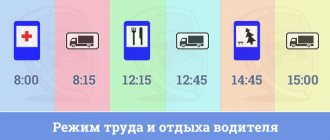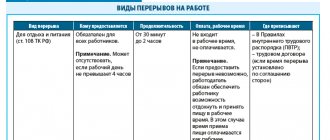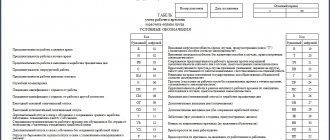To answer this question, it is necessary to study the current norms of the Labor Code of the Russian Federation. There is no single correct answer in the code, since it is possible to approve different modes of work activity, taking into account production needs (work in shifts, for example). The duration of the day shift is clearly established only for certain categories of workers, but there is a categorical rule for the duration of work per week. In Russia, labor legislation establishes a standard working week of no more than 40 hours.
According to Art. 104 of the Labor Code of the Russian Federation, it is allowed to introduce in exceptional cases a summarized accounting of time worked, when it is not possible to comply with the daily or weekly norm. The summary accounting is entered by order of the manager, the employee is introduced to it under his signature.
What are working hours
The definition of this concept is contained in Art. 91 Labor Code of the Russian Federation. According to this norm, this is the period of the day during which the employee performs direct job duties in accordance with the established rules and conditions specified in the contract.
The length of the working day according to the Labor Code of the Russian Federation is limited only by the upper limit - this is stated in Art. 91 Labor Code of the Russian Federation. Normal weekly working hours cannot exceed 40 hours. This rule applies to all employees, regardless of how many days they work: 5 or 6. And everything in excess of the norm is overtime (with the exception of the summarized accounting system and irregular days). The employer is charged with recording labor activity and has the right to approve the chosen labor regime in local regulations.
The most common answer to the question of how many hours a working day is according to the Labor Code is 8. This is the duration for a standard five-day week (calculated using the formula 40 / 5 = 8). But the daily norm is not strictly regulated in the Labor Code of the Russian Federation. So, if a six-day period is introduced, the daily duration of labor according to this formula will be 40 / 6 = 6.67. In practice, a different scheme is used: a 7-hour day from Monday to Friday and a 5-hour day on Saturday (see Part 3 of Article 95 of the Labor Code of the Russian Federation).
The Labor Code of the Russian Federation and other acts do not approve the minimum working hours; it can be established by local acts. But in Art. 102 of the Labor Code of the Russian Federation there is an indication of the employer’s obligation to provide the employee with a flexible schedule (when the beginning and end of the shift are determined by agreement of the parties) to work the total number of hours during the accounting period.
Accounting
The calculation of hours worked is carried out directly by the employer . This gives him a number of advantages.
First, correctly calculate wages, subtracting weekends, vacations, and compensatory days. This leads to significant cash savings. Secondly , the manager will be able to check the whereabouts of the employee at any time and apply punishment in case of his absence. Starting from deprivation of bonuses to making up missed hours.
Let's turn our attention to another document.
This is order No. 588n of the Ministry of Health and Social Development dated August 13, 2009. It allows you to clearly regulate the number of working hours per week. According to the document, a worker must work 8 hours per day with a 40-hour work week.
Another point. What if a worker works 48 hours a week? Of course, this is not legal, but Order No. 588n allows you to calculate the length of the working day.
Accordingly, the number varies from 24 to 40. Divide the required number by 5 and multiply by the number of working days per month. However, there is one more nuance. From the resulting number, subtract the number of hours that fall on shortened working days.
ATTENTION! Article 95 of the Labor Code of the Russian Federation states that working hours on a pre-holiday day are reduced by an hour.
It should be noted that time tracking can be of three main types: by day, by week, or combined. Let's look at each in more detail:
- Accounting by day. Convenient when working hours are regulated. It doesn't change from day to day. By the way, many companies in Russia adhere to this schedule. Any overtime is paid as overtime.
- Accounting by week . Most often used with a flexible schedule (Article 102 of the Labor Code of the Russian Federation). According to it, the employee can independently choose the beginning and end of the working day, as well as its duration, by prior agreement with the employer.
- Combined . Used in the case of a shift schedule (Article 103 of the Labor Code of the Russian Federation) or a rotational schedule (Article 300 of the Labor Code of the Russian Federation). In this case, it is not possible to count working hours per week. Usually this is several months, 10, 20 or more days.
The calculation is largely influenced by the specifics of work at a particular enterprise. Moreover, the total working time cannot be more than 40 hours per week.
The employer records absolutely all time parameters. This applies to any work schedule, as well as overtime. Moreover, the employee can independently familiarize himself with the accounting and calculate the time worked if any questions arise regarding payroll.
Who is entitled to reduced working hours?
For some categories of workers, a different working week in hours is established according to the Labor Code of the Russian Federation - shortened (Article 92 of the Labor Code of the Russian Federation):
- for teenagers under 16 years of age - no more than 24 hours a week;
- for workers aged 16 to 18 years - 35;
- specialists working in enterprises with harmful and dangerous working conditions are required to work no more than 36. It is required to take into account the results of the SOUT;
- doctors should work no more than 36 hours;
- teachers - no more than 36;
- employees working in the Far North and equivalent areas and in rural areas are assigned to work no more than 36;
- and the length of working hours for disabled people of groups 1 and 2 is no more than 35 per week.
Separate regulations establish other indicators for certain categories of citizens or representatives of certain professions. The legislation does not impose minimum requirements.
ConsultantPlus experts discussed how to determine the length of the working day. Use these instructions for free.
Why is the average duration calculation required?
Average values are needed to calculate how effectively working time is used. In particular, if you divide the actual duration by the established one, you can calculate the working time utilization rate. It shows what part of the time that, according to the standards, is allocated for work, is actually used. Also, this coefficient is an integral part of any economic calculations that make it possible to determine how productive the labor of both a particular category of workers and the entire workforce of the enterprise as a whole is.
For example, you can calculate the following indicators:
- average output per employee per day, week or month;
- average hourly output per work shift;
- labor intensity of production.
As a result of the analysis, the management of the enterprise will be able to find out how efficiently the work is being done and how successful the personnel policy is. Accounting for working hours is a necessary part of the overall analysis of the enterprise.
In addition, comparing the average actual duration with the average lesson time allows you to estimate how great the loss of working time is. Knowing them, you can plan further steps to reduce losses and make the most efficient use of the working time fund in the organization. All this is a necessary part of enterprise management, without which it is impossible to build a personnel policy and plan work for the future.
In what cases can the working day be reduced?
How long a particular employee works is indicated in his contract. Thus, by agreement between the parties, it can be issued for a partial period of time (Article 93 of the Labor Code of the Russian Federation). The boss does not have the right to refuse a request to establish a shortened day or a short week for the following categories of workers:
- pregnant employees;
- a parent (guardian, trustee) raising a child under 14 years of age (or a disabled child under 18 years of age);
- employees caring for a sick family member (this need will have to be confirmed by a medical certificate).
Partial time is set for a period convenient for the employee, but not more than for the period of existence of circumstances. When determining the schedule of work time and rest time, the wishes of the employee are taken into account. It is worth knowing that such measures will not affect the rights of a citizen, in particular, the length of leave and length of service. Only for money.
Each boss keeps records of the time worked by employees. For example, an employer may need to find out the average working hours during a working day.
The average working day is a parameter that shows how many hours of work per employee per day.
How is it calculated? The formula used for the average working day is:
SPr = OKCHChr / KD,
Where:
- SPr - average length of day;
- OKChChr - the total number of man-hours worked;
- CD - number of days in the accounting period.
To determine the average for all employees, another formula is used:
SP = OKCH / KR,
Where:
- SP - average duration;
- OKCH - the total number of man-hours worked at the enterprise;
- KR - number of employees.
Other averages that may be considered by the organization
The above formulas reflect only the average total actual duration. In some cases, other concepts are used for economic analysis:
- The average established (also regime) duration is an average calculated taking into account the official requirements for the duration of the working day in man-hours imposed on certain categories of workers. Calculation of this indicator may be required in cases where the enterprise has workers with different working hours in order to determine how effective the work of each category of workers is. For example, workers employed in hot shops or hazardous industries must have a shorter work shift than others (Article 92 of the Labor Code of the Russian Federation). Thus, if an enterprise has 2000 employees, of which 1900 work 8 hours a day, and 100 have benefits (because they work in hazardous conditions, are minors, etc.) and work 7 hours a day, to calculate the average the regular working hours will need to divide the sum of man-hours worked in both categories by the number of workers: (8 × 1900 + 7 × 100) / 2000 = 7.95.
- Average lesson duration - here the calculation uses man-hours worked only at the time established by the schedule, without taking into account overtime work.
The calculation is carried out for the period necessary to carry out the analysis (month, week, half-year, quarter, etc.). The calculation is carried out according to the formula: SU = (OKCHCH - OKCHChsu) / KD, where SU is the average workday, OKCHCH is the total number of man-hours, OKCHChsu is the total number of man-hours worked in overtime, KD is the number of days in the billing period.
Working hours for teaching staff
Article 333 of the Labor Code of the Russian Federation states: for teaching staff, a reduced working time is established - no more than 36 hours per week.
The length of teachers’ working hours is determined individually and depends on the following factors:
- job title;
- standard hours per rate;
- contract teaching load;
- upper limit of teaching load (2 rates).
Detailed information about the accepted standards for the length of working time for teaching staff is presented in Order No. 1601 of the Ministry of Education and Science dated December 22, 2014.
As a conclusion, how long a working day lasts according to the Labor Code is not indicated in any article in this regulatory act; there are restrictions only for workers from certain preferential categories. So. children aged 14 to 15 work no more than 4 hours a day, from 15 to 16 years - no more than 5, from 16 to 17 - no more than 7. If young employees combine work with training, they work no more than 2 hours a day .5 hours (if you have not reached the age of 16), from 16 to 18 years old - no more than 4. For workers in hazardous industries, separate limits are established - 8 hours for a 36-hour work week, 6 for a 30-hour work week or less.
The Labor Code of the Russian Federation clearly regulates only the maximum duration of the working week - 40 hours.
Classification of types of working time according to Labor Code
Working time should be understood as periods of working activity:
- with a standard duration of 8 hours;
- within the framework of reduced working hours;
- not completing the full scope of work;
- overtime work performed outside the standard;
- irregular working hours established by local regulations of the organization.
The Labor Code also includes other periods in the concept of working time, for example:
- breaks for rest and meals (lunch), when the employee cannot leave the place of work (in accordance with Article 108 of the Labor Code);
- breaks provided for in Article 109 of the Labor Code, which must be provided under certain conditions (working in the cold season in the open air or in unheated rooms) for rest and heating;
- time of separation from work for a woman breastfeeding.
Let us note that the employer is obliged to pay for the working time of each employee, including all overtime hours in excess of the normal shift duration and shortcomings caused by the employer.
Total accounting of working time - calculation examples
The rules for calculating the hourly rate for the purposes of calculating wages are determined by the employer and must be recorded in the local regulatory legal acts. This is mandatory because different calculation methods give different results for the amount of income an employee receives in a particular month. So, a summary record of working time in those areas of work where, for objective reasons, it is not possible to maintain the normal duration of work per week, in order to compensate for deviations in the duration of one work week in subsequent ones over a longer period. the use of summarized recording of working time , in particular, in case of rotational work (Art.
300 of the Labor Code of the Russian Federation), flexible working hours (Article 102 of the Labor Code of the Russian Federation), shift work (Article 103 of the Labor Code of the Russian Federation). The period of time adopted by the employer to calculate the number of hours of work for the purpose of standardization is called the accounting period. The duration of work duties during the accounting period should be no more than a normal week, multiplied by the number of weeks in the accepted accounting period.
The maximum length of the accounting period in the general case is 1 year (Article 104 of the Labor Code of the Russian Federation). It seems appropriate to set an hourly rate calculated on the basis of the monthly norm for an accounting period other than 1 month, but less than 1 year, and for an annual accounting period - an hourly rate calculated on the basis of the annual working time norm. Formula for Calculating Working Time per Day
Read on the Russia-Ukraine website:
- If you go on maternity leave from temporary headquarters in the civil service
- Claim for Recovery of Damages of an Enterprise during Air Transportation How to Collect Through Arbitration
- Can a Court Forgive Drunk Driving?
- Presidium of the Regional Court Which Instance
- Sanctions for Late Payment of Severance Pay in 2020
Attention!
Due to recent changes in legislation, the legal information in this article may be out of date! Our lawyer can advise you free of charge - write your question in the form below.
Standard working hours per day
The modern Labor Code does not provide information on how many hours a standard working day should last. This is the number of hours that directly depends on the schedule established for a particular job position.
Enterprises and organizations operating today can work using work schedules that vary in time:
- Five-day work week and two full days of rest. One standard day in such a situation lasts 8 hours;
- Six days and one day of full rest. The day shift in this case averages 7 hours. On the last day before the scheduled rest day, the work time is automatically reduced to 5 hours;
- Work according to schedule. In such a situation, the time of a standard work shift is not regulated. In certain factories or hospitals, one shift can last up to 24 hours. The main thing here is to adhere to the rule - you are allowed to work no more than a full 40 hours. This is a parameter specific to one week.
The employer independently determines the general working hours in his company. And here it is not necessary to set one schedule. You can use several at the same time. It all depends on the position the person occupies and the specifics of the enterprise.
How to calculate working hours with a six-day work week
Now let's move on to October, when "extra" Saturdays will provide "extra" hours. Do I need to pay overtime? Here we need to carefully study Article 99 of the Labor Code of the Russian Federation, which defines overtime work. It refers to work performed by an employee at the initiative of the employer outside the working hours established for the employee: daily work (shift). The duration of working hours is again fixed in the employment contract and (or) internal labor regulations. This means that if the duration of each work shift during a month does not exceed what is stated in the employment contract (and in Article 91 of the Labor Code of the Russian Federation), then overtime work cannot occur. So the employer is not required to make any additional payments.
Thus, it can be stated that in both cases under consideration we are talking only about a mathematical discrepancy in the norm of working time, caused by the imperfection of the mechanism for calculating this norm, enshrined in order No. 588n. Accordingly, this imperfection cannot lead to any negative consequences for the organization, but it is necessary to know about it, precisely in order to correctly calculate the standard working time for “six-day workers.”
Formula for calculating working time fund and its features
This thesis can be easily illustrated with the following example: the production process involves n employees who must do a certain amount of work or produce the required amount of product on time. Profit directly depends on how effectively management can use the working time fund. A bloated staff, with the connivance of administrative staff, spends working time on non-work matters, but requires a large amount of money for wages . Also, calculating the time that will be spent by employees performing official duties is required to calculate production standards and achieve planned indicators . For successful business planning, the concept of a working time fund is introduced.
Another formula allows management to regulate the number of personnel involved in performing certain work. For example, to produce 800 parts ordered by a company, 800 man-hours are required. 800/8 = 100 days. During this period, this volume can be provided by 1 worker. Analysis of the working time fund allows you to take measures to increase labor productivity.
To do this, the efficiency factor is calculated: the ratio of effective working time to nominal working time. If this number for a particular worker approaches one, he can be considered a valuable personnel . Due to the human factor, downtime is common.
Penalties for idleness at work, a clear definition of time for “tea and smoke breaks”, inadmissibility of being late for an unexcused reason, control over the continuous performance of official duties - these are measures that will significantly increase labor productivity in the team .
Every employer knows that overtime work is paid according to slightly different rules. In addition, the duration of such work cannot exceed a certain limit per month. In order to save money on paying overtime hours, employers began to use summarized recording of working hours. This calculation is used in cases where it is not possible to maintain the normal working week.
For example, employees work in shifts. With such a work schedule, it is necessary to use not only a different accounting of working hours, but also calculate wages differently. To comply with the law and increase labor efficiency, the employer introduces shift work schedules. To avoid violations, it is necessary that the duration of work duties during the accounting period is no more than a normal week, multiplied by the number of weeks in the accepted accounting period.
The maximum length of the accounting period is generally 1 year, according to Art. 104 Labor Code of the Russian Federation. Overtime work is working beyond one's normal work schedule. Recently, more and more often, workers have begun to stay at their workplaces beyond the normal 8-hour working time.
And if a shift schedule is approved, then overtime occurs constantly.
- Sunday must be counted as a day off. And it doesn’t matter how many days of rest a subordinate actually has per week - 2 or 1. For some categories of subordinates, it is possible to transfer the day of rest to another date.
- Don't forget about official holidays, which are not used in calculations.
- When a holiday falls on a day of rest, the day off is postponed. These rules do not need to be used only when calculating labor standards for January.
- The length of the working day before a holiday is always reduced by 1 hour.
Determining labor standards allows employers to correctly set work schedules, keep records of hours worked, pay wages and distribute vacations. Knowing how to correctly calculate the standard working time, you can easily determine how many hours an employee must work. One calendar month is often taken as the billing period.
Labor rationing is an important procedure that allows you to determine the number of hours that employees are required to work. When making calculations, the calendar year is often used as the accounting period. Hours are calculated in two ways. You can use the method that is used to calculate the quarter.
You just need to determine the amount of the working period for all 12 months. Another procedure for determining the norm was established by order of the Ministry of Health and Social Development of the Russian Federation No. 588n. The calculation is carried out using the formula: 40/5*number of working days per year.
After this, from the resulting number you should subtract the number of hours that the employees did not work. We are talking about reductions before the holidays.
Formula for calculating working time fund and its features
- How to determine the utilization rate of the calendar FW: it is necessary to divide the actual time worked (man-days) by the calendar fund of working time;
- How to find the coefficient of time use: it is necessary to divide the actual time worked (man-days) by the time FRF;
- How to find the coefficient of utilization of the maximum possible working time: it is necessary to divide the actual time worked (man-days) by the time-of-care factor;
- How to find the time utilization factor: it is necessary to divide the average actual duration of working days (man-days) by the average maximum possible number of man-days;
- How to find the working day utilization rate: you need to divide the average actual length of a working day by the average approved workday.
For example, the annual fund per employee is equal to 365 (366) man-days, and per team of 100 people it is already 36,500 (36,600) man-days. The calendar fund of working hours allows you to calculate the average number of employees. It is a good start for calculating other possible funds (period and maximum).
The time sheet fund for recording working hours is the total number of payroll numbers for working days in a certain period. The time fund is calculated as follows: the calendar fund of the working period is taken as a basis, from which holidays and weekends are subtracted, or more precisely, this is the number of actual working days in the organization. Documentation support for work with personnel
- Meets the requirements of the professional standard “Human Resources Management Specialist”
- For passing - a certificate of advanced training
- Educational materials are presented in the format of visual notes with video lectures by experts
- Ready-made document templates are available that you can download and keep for your work
Payroll calculation for part-time work
According to the norms of the Labor Code of the Russian Federation, if an employee performs his labor function under the condition of part-time work (part-time or week), then wages must be accrued in proportion to the time of work. In this case, the minimum wage must be changed in accordance with the quantitative indicator of working hours.
As a general rule, the standard length of a working week should not exceed forty hours, but in practice there may be cases when an employee can work less time. In particular, if he was undergoing treatment, was on vacation or got a job not from the beginning of the calendar month.
Regardless of the type of activity, every firm or company wants to get the best results in return for the efforts made by its employees. To realize this desire, it is necessary to monitor the main indicators characterizing the labor process and its efficiency, in particular, the average length of the working day, as well as the exact implementation of prescribed labor standards.







